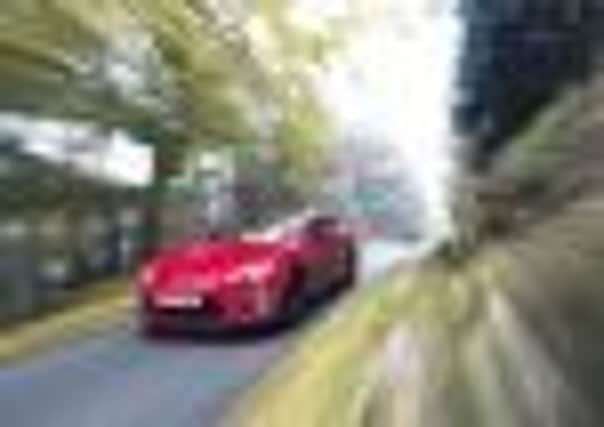Motoring review: Toyota GT86


The car is a joint venture sports 2+2 coupé developed by Toyota as the GT86 and Subaru as the BRZ. They are built at the same Subaru factory in Japan. They have the looks and the pedigree to challenge the pert Audi and a classic rear-wheel-drive layout.
The engine is a Subaru 2-litre petrol flat-four which gives a lower centre of gravity than an upright engine. It has Toyota’s direct fuel injection and drives through Subaru six-speed manual or automatic gearboxes. The engineering and manufacturing was led by Subaru. Toyota led on external design and the chassis. Both companies weighed in on all disciplines, bringing the strengths of giant Toyota and imaginative Subaru to the table.
Advertisement
Hide AdThe exterior brings vivid memories of the Celica and Supra coupés. The main design differences between Toyota and Subaru are at the front and both models have the same prices – with Subaru adding a higher-spec version off the shelf. My test car is the automatic Toyota. However, assume the BRZ to have the same characteristics – none of which should put you off if you like a sporty light coupé. One caveat, the Toyota has softer springing.
Its 2+2 seating makes it a practical proposition for the 2+2 household – as long as the +2 are smallish and the first 2 are not too leggy. The seat back folds down to extend the boot space.
At 167 inches long it gains a couple of inches on the Audi TT and the roadside appeal is immediately apparent. Even painted in black, dulled by matt black bodywork stripes, it catches attention. The common comment was how much it looked like a Celica though in reality the GT86 is more muscular over the shoulders.
The GT86 takes its name from Toyota sports cars of the past – shown in a delightfully confusing badge. The single high specification includes a limited slip differential, dual-zone climate control, sports seats, bi-xenon headlights and 17-inch alloys. Bi-xenon high intensity discharge headlights, LED daytime running lights, front fog lamps and electric folding door mirrors with housings matched to the car’s body colour, cruise control, hill-start assist, scuff plates and the Toyota Touch touchscreen control system for the six-speaker audio, with Bluetooth for phone and music streaming, and a USB port. As an option, you can upgrade to Toyota’s excellent Touch and Go for £750. This brings navigation and functions such as speed and safety camera warnings, on-board connection to Google and (via subscription) connected services providing data such as live parking and fuel price information and local weather forecasts.
The GT86 badge is a small but attractive detail just forward of the base of the A-pillars, depicting four drifting tyres within the number 86, set between two horizontal “boxer” pistons. See if you can work it out.
Inside the car the driver sees the bulge over the front wheels. Through the frameless mirror the view is obstructed by a high-level brake light which looks like a post-production addition on the rear shelf. A push button starter brings the car to life and you hear a new and lovely sound from Subaru’s well-known flat four. It has been rebuilt to rev higher, with lighter pistons in a modified block and heads, running to 7,400rpm at a raised compression ratio. The absence of a turbo or supercharger may seem unusual but it does mean a return to a traditional rear-driven sports car with adequate acceleration. It is likely a more powerful model will follow but there are no stated plans for a convertible.
Advertisement
Hide AdThin body steel with an aluminium bonnet keeps the weight down. The lightweight build is evident when you catch a foot on the sill and hear it twang. Metal-faced pedals and bucket seats set the tone. The instruments are suitably stylish, with a carbon graphite back texture which is repeated on the fascia. The urban speed limits are lost at the bottom of the dial but you have a large digital read out and (with the navigation system) a speed limit display which turns red if exceeded. Like many of these “readers” it can be wrong so do not rely on it if you don’t know the limit for the road you are on. Do you wonder why urban roads do not have more frequent speed limit signs?
An automatic gearbox lacks the immediate gutsy alacrity of a manual box and a couple of other drivers criticised the acceleration. Both, by the way, were “normal” female drivers. Odd, because I like a bit of pounce and had no complaints. The engine emits a sharp note to enhance the perception.
Advertisement
Hide AdThe gear change, even on the normal setting, can snatch. You have the option of a Sport response and also choosing a stability programme which allows more slippage. Paddle shifters behind the steering wheel provide manual selection for the keener driver.